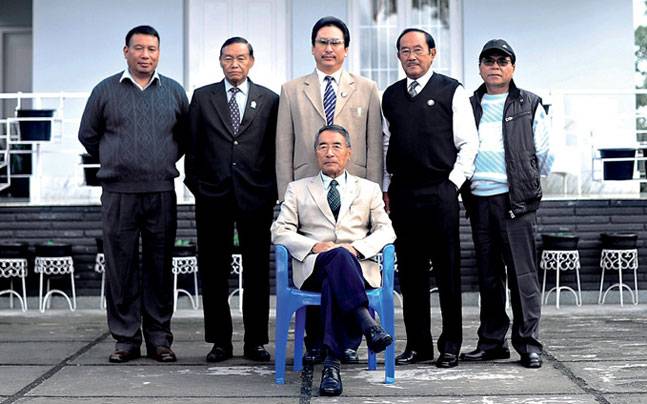Nagaland: Political history
(→2017) |
(→Major agitation in 2017) |
||
| Line 30: | Line 30: | ||
Mobile data, SMS and internet services were snapped across Nagaland for at least five days. The state government had cut off these services on Monday 20 Jan to avoid spreading of rumours in view of the protests. | Mobile data, SMS and internet services were snapped across Nagaland for at least five days. The state government had cut off these services on Monday 20 Jan to avoid spreading of rumours in view of the protests. | ||
| − | |||
| − | |||
| − | |||
| − | |||
| − | |||
| − | |||
| − | |||
| − | |||
| − | |||
| − | |||
| − | |||
| − | |||
| − | |||
| − | |||
| − | |||
| − | |||
| − | |||
= 2017 = | = 2017 = | ||
== Naga Power Play == | == Naga Power Play == | ||
Revision as of 15:51, 13 June 2017
This is a collection of articles archived for the excellence of their content. |
Contents |
33% reservation for women in urban local bodies (ULBs)
Major agitation in 2017
Xavier Rutsa, Nagaland bows to vandals, declares polls null & void Feb 04 2017 : The Times of India
Nagaland was on the boil ever since the T R Zeliang government decided to implement 33% reservation for women in urban local bodies (ULBs). Elections to 10 town councils, which were held on Wednesday 1 Feb 2017 despite opposition from all 15 Naga tribes, were 2 days later declared null and void in view of the prevailing situation.
On Thursday 2 Feb night, protesters torched buildings housing at least 20 government offices and the Kohima Press Club. The offices of the Kohima district collector and Nagaland commissioner were also stoned. The ruling Naga People's Front (NPF) office was also reportedly vandali sed and set on fire.
Tension prevailed in Kohima on Friday 3 Feb, a day after protesters set ablaze many government buildings and vehicles to oppose quota for women in the ULB polls. Bodies of two agitators who were killed in Dimapur police firing were laid to rest as thousands of mourners gathered in the state capital to pay their last respects.
An indefinite bandh called by the Angami Youth Organisation (AYO) was enforced by it in Kohima and Dimapur.
Kohima deputy commissioner and district magistrate Rajesh Soudararajan imposed Section 144 of the Criminal Procedure Code in four areas, including the Raj Bhavan, following the violence.
Nagaland governor P B Acharya arrived at Raj Bhavan from Itanagar on Friday 3 Feb and met members of the newly formed Nagaland Tribes Action Committee (NTAC), which comprised representatives of all apex Naga tribes.NTAC reiterated its demands before the governor, which include resignation of the CM and his cabinet and suspen sion of police personnel involved in the firing on Tuesday and Wednesday . NTAC convener K T Velie said the governor promised he would take action as per the Constitution.
Mobile data, SMS and internet services were snapped across Nagaland for at least five days. The state government had cut off these services on Monday 20 Jan to avoid spreading of rumours in view of the protests.
2017
Naga Power Play
Kaushik Deka , Naga Power Play “India Today” 6/3/2017
Shurhozelie Neiphiu Rio, former Nagaland chief minister and sole Lok Sabha member from the Naga People's Front (NPF), had a dream. He wanted to be CM again.
He had already served three consecutive terms, quitting in 2014 because he thought he had a shot at becoming a cabinet minister. At the time, NPF leader T.R. Zeliang had eagerly stepped in to fill the vacated post. But though Rio was elected to Parliament, he was overlooked for a cabinet post.
With Zeliang forced to resign in February this year-after Nagaland was riven by protests against his decision to implement 33 per cent reservations for women in civic elections-Rio became the obvious favourite.
But in a byzantine turn of events, NPF president Shurhozelie Liezietsu was sworn in as Nagaland's 11th chief minister on February 22 instead, highlighting the BJP's role as kingmaker in the state.
The story goes back to at least last year. In May 2016, Rio was suspended from the NPF for 'anti-party activities'; specifically, scheming to become chief minister again, at the expense of Zeliang.
That was a significant setback, but when the Nagaland Tribes Action Committee (NTAC) and Joint Coordination Committee shut down the entire state before the February 1 urban local bodies polls, Rio knew he had his chance. The NTAC announced that it would not relent until Zeliang stepped down; it was probably not a coincidence that a key member of the group was closely associated with Rio.
That was when the BJP intervened. Though it has only four legislators in the opposition-less Democratic Alliance of Nagaland (DAN) coalition government-the NPF is the major constituent with 48 legislators-it wields considerable influence.
On February 17, under pressure from NTAC, 39 NPF MLAs had asked Zeliang to step down. He flew to Delhi and had a closed-door meeting with BJP national general secretary Ram Madhav. The BJP had to be careful not to alienate Rio given his rapport with National Socialist Council of Nagaland (Isak-Muivah) leaders.
And so, Madhav arranged a meeting between Rio and Zeliang, and a deal was struck, in which Zeliang would become finance minister in a new Rio government.
However, the deal fell through. The NSCN (I-M)'s economic blockade of Manipur had become an insupportable problem for the BJP's brass, hurting the party's chances in state elections beginning March 4.
And in the end, it was Rio's earlier suspension that settled matters. Enter Liezietsu, with a rather unceremonious exit for Rio.
